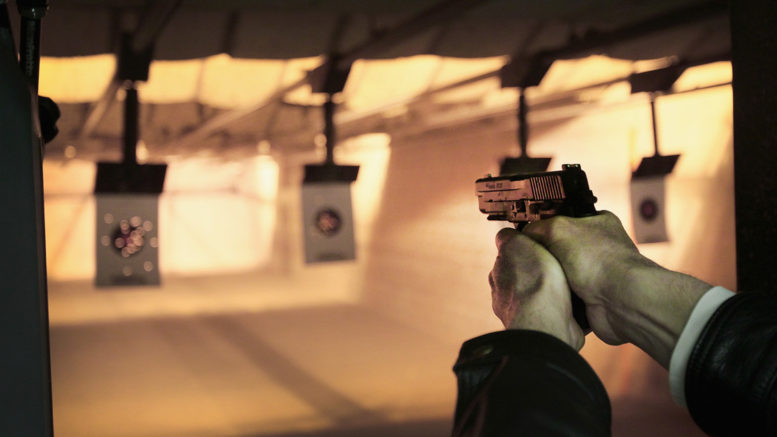You know, it still amazes me how many people take a Concealed Carry Handgun class, and then you run into them months, or even years later and ask them when they went shooting last. Their response usually is “at my concealed carry class”, as they sheepishly look at the ground, avoiding eye contact with you. Folks, that ought not to be! It is a very well-known fact that first person in a gun fight with accurate shots on target, wins the gunfight! The end result is speed and accuracy. We hope that none of our students ever have to defend themselves with a firearm, but in the event that they have no other safe options, we pray that they will do well. It boils down to how well you know your equipment (gun, holster, ammunition, etc.), how accurate you are under stress, how well can you handle that gun under the stress of a self-defense situation, and of course, how well do you know the law. The more you rehearse these items, the more proficient you will become! Let’s break it down to the ridiculous.
Marksmanship
To say that you will just point and shoot is a huge understatement. First and foremost, you will need to MASTER the fundamentals of marksmanship, with an emphasis on aiming and trigger control. If you took your Concealed Carry Course from us, you were taught all of that. You also will be taught this information in an NRA Basics of Pistol Shooting Course. Then enroll in training such as NRA Personal Protection in the Home, where we teach you flash sight shooting and point shooting, and our exclusive Every Day Carry Course, which gets into shooting on the move, using cover and concealment, shooting under stress, shoot/don’t shoot decisions, emergency procedures, firearms retention and split second decision making. Don’t forget competitive shooting which goes on at most of our local ranges. All of this works toward one goal. Competency!
Familiarity
To be the next Jerry Miculek on the target, may be one thing, but if you cannot draw your gun from your holster, you might have a problem. I’ve never been one to insist on a certain type of holster. No matter what you use, make sure you know its abilities and its limitations. That also goes with your wardrobe. If you have mastered getting a gun out from an appendix carry holster with jeans and a tee shirt, try it with a suit and tie. As you change your clothes, you will notice that some outfits present their own set of challenges. Make sure you dry-fire train (ammo in a different room) with all of them.
Familiarity with your gun, ammo, magazines, speed loaders, and any other primary defense equipment must not be overlooked. You must become extremely, intimately familiar with all of it prior to carrying it in the public.
The combination of these two will be the basis and the solid foundation for your next stop on the trail to competence..
Speed (and accuracy)
You must first master pistol marksmanship and emergency clearing procedures, as well as know your gun well enough to field strip it in your sleep (or at least load and unload it). When progressing through pistol marksmanship, you start out very slow and up close. When you start shooting 1-2 inch groups, speed up. When your groups begin to tighten, move back. Don’t start out with the challenging shots, but take baby steps to get to where you want to be that training day. As you progress, get yourself a collection of pistol training drills and do them! Get good at them. Challenge your shooting buddies to them and help them to improve. Keep it fun and keep it moving. Achieving this level of competency leads to the next step…
Fast decision making
If you have trained, as described previously, to the point that you feel competent, you are then set up for success. You see, the truth of the matter is that if we are faced with a deadly force threat, we really do not know what we will do, until that moment arrives. But that is not a time when you want your thinking to be fogged by unfamiliarity or doubting your own marksmanship abilities. The reason is simple, you are being faced with a life or death situation in which you now, with your gun drawn, have to make a nano-second decision in which the deadly force laws will cover you. In our Every Day Carry Course, we have a judgmental shooting scenario, in which the students are faced with a situation, and they have 2 seconds to make a decision, then they must immediately articulate what happened and how the law either covers them or doesn’t cover the decision that they just made. We had one student who, when faced with the threat, froze. When asked what happened, she said that she doubted her marksmanship skills. So we regrouped and ran the drill again, and she shot the hostage taker (on the target) with a perfect head shot right in the middle of his nose! The more you train, the more your faith in your skill set will be, the less your thinking will be clouded when you need it most! That shooter had been to a lot of other trainings in her military career, as well as some commercial trainings. After that incident, she told me that she learned more in the last five minutes than she had ever learned in any of her other training. That is the power of split-second decision making. You must master that too.
In conclusion
It all depends on whether or not you are practicing and then training. Those who know me, know my philosophy on this.
Practice – doing the skill over and over until you get it right.
Training – doing the skill right over and over until you can no longer get it wrong.
Make sure you are doing your training! Schedule it, and discipline yourself to do it. Your loved ones love you more alive than dead. They depend on you to be able to adequately defend yourself. They want their Mom, Dad, brother, sister, son, daughter, husband or wife to be around for a long time. With the world getting so riddled with violent crimes, these skills are not optional. You owe it to them to master these skills. See you on the range!

